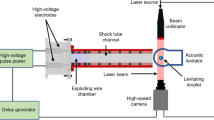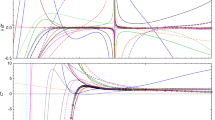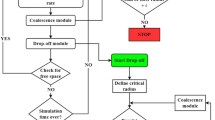Abstract
For small droplets undergoing phase change, gravity is generally considered negligible. In the case of binary droplets evaporation, convective flows can be induced due to various mechanisms, such as continuity, buoyancy and/or selective evaporation of one of the components. Convection can also be induced by surface tension gradients resulting from concentration variations along the interface. This study presents experimental results of evaporation for binary mixture droplets. We concurrently investigate sessile and pendant droplets to assess gravity’s impact on binary droplet evaporation. We examine compositions including, pure butanol, pure methanol, pure water, and 50% per volume mixtures of water-butanol and water-methanol, evaporating in a controlled atmosphere. In the case of water-butanol mixtures, the drops contact line ‘depins’ during the evaporation process whereas the case of water-methanol mixture, the contact line of the drops remains pinned most of the lifetimes. The analysis of the evaporation dynamics reveals differences in the evaporation of these two mixtures and the effect of orientation (gravity). For water-butanol mixtures the evaporation occurs in four stages linked to preferential evaporation of the more volatile component and the ensuing surface tension gradients. In the case of water-methanol mixtures, contact lines tend to be pinned during most of the lifetimes of drops. The evaporation rate of the mixture is found to be between the ones of the pure components, i.e. water and methanol. The case of sessile drops exhibits a slight enhancement in evaporation rate in the case of the sessile configuration compared to the pendant one for pure water and mixture cases, which is explained by density differences and buoyancy driven flows. Solutal Marangoni flows in the case of water-methanol mixtures are deemed weaker compared to water-butanol ones. The use of the two mixtures allowed to have a good comparison between two cases where solutal-Marangoni effect can be strong (water-butanol) and weak (water- methanol) influence. The densities of the two organic liquids also highlighted gravitational effect due to the large difference in vapor densities.















Similar content being viewed by others
Data Availability
No datasets were generated or analysed during the current study.
References
Abe, Y., Tanaka, K., Mochizuki, M., Sato, M., Nakagawa, M., di Francescantonio, N., et al.: Heat pipes with self-rewetting fluids. In: Proceedings of 8th international heat pipes symposium, Kumamoto, pp 76–81 (2006)
Bennacer, R., Ma, X.: Effect of temperature and surfactants on evaporation and contact line dynamics of sessile drops. Heliyon. 8(11), e11716 (2022). https://doi.org/10.1016/j.heliyon.2022.e11716
Bennacer, R., Sefiane, K.: Vortices, dissipation and flow transition in volatile binary drops. J. Fluid Mech. 749, 649–665 (2014). https://doi.org/10.1017/jfm.2014.220
Brenn, G., Deviprasath, L.J., Durst, F., Fink, C.: Evaporation of acoustically levitated multi-component liquid droplets. Int. J. Heat. Mass. Transf. 50(25), 5073–5086 (2007). https://doi.org/10.1016/j.ijheatmasstransfer.2007.07.036
Brutin, D., Starov, V.: Recent advances in droplet wetting and evaporation. Chem. Soc. Rev. 47(2), 558–585 (2018). https://doi.org/10.1039/C6CS00902F
Chong K.L., Li, Y., Ng, C.S., Verzicco, R., Lohse, D.: Convection-dominated dissolution for single and multiple immersed sessile droplets. J. Fluid Mech. 892, A21 (2020). https://doi.org/10.1017/jfm.2020.175
Christy, J.R.E., Hamamoto, Y., Sefiane, K.: Flow transition within an evaporating binary mixture sessile drop. Phys. Rev. Lett. 106(20), 205701 (2011). https://doi.org/10.1103/PhysRevLett.106.205701
Dehaeck, S., Rednikov, A., Colinet, P.: Vapor-based interferometric measurement of local evaporation rate and interfacial temperature of evaporating droplets. Langmuir. 30(8), 2002–2008 (2014)
Devlin, N.R., Loehr, K., Harris, M.T.: The importance of gravity in droplet evaporation: A comparison of pendant and sessile drop evaporation with particles. AIChE J. 62(3), 947–955 (2016). https://doi.org/10.1002/aic.15120
Diaz, M.E., Savage, M.D., Cerro, R.L.: The effect of temperature on contact angles and wetting transitions for n-alkanes on PTFE. J. Colloid Interface Sci. 503, 159–167 (2017). https://doi.org/10.1016/j.jcis.2017.05.003
Diddens, C., Tan, H., Lv, P., et al.: Evaporating pure, binary and ternary droplets: Thermal effects and axial symmetry breaking. J. Fluid Mech. 823, 470–497 (2017). https://doi.org/10.1017/jfm.2017.312
Diddens, C., Li, Y., Lohse, D.: Competing Marangoni and Rayleigh convection in evaporating binary droplets. J. Fluid Mech. 914, 1–26 (2021). https://doi.org/10.1017/jfm.2020.734
Edwards, A.M.J., Atkinson, P.S., Cheung, C.S., Liang, H., Fairhurst, D.J., Ouali, F.F.: Density-driven flows in evaporating binary liquid droplets. Phys. Rev. Lett. 121(18), 184501 (2018). https://doi.org/10.1103/PhysRevLett.121.184501
Foudhil, W., Chen, P., Fahem, K., Harmand, S., Jabrallah, S., Ben: Study of the evaporation kinetics of pure and binary droplets: Volatility effect. Heat. Mass. Transf. und Stoffuebertragung. 57(11), 1773–1790 (2021). https://doi.org/10.1007/s00231-021-03043-8
Gobin, D., Bennacer, R.: Cooperating thermosolutal convection in enclosures—II. Heat transfer and flow structure. Int. J. Heat Mass Transf. 47, 201–208 (1996). https://doi.org/10.1016/j.ijthermalsci.2007.02.010
Ho, C.K.: Evaporation of pendant water droplets in fractures. Water Resour. Res. 33(12), 2665–2671 (1997). https://doi.org/10.1029/97WR02489
Hu, H., Larson, R.G.: Evaporation of a sessile droplet on a substrate. J. Phys. Chem. B. 106(6), 1334–1344 (2002). https://doi.org/10.1021/jp0118322
Kim, H., Boulogne, F., Um, E., Jacobi, I., Button, E., Stone, H.A.: Controlled uniform coating from the interplay of Marangoni flows and surface-adsorbed macromolecules. Phys. Rev. Lett. 116(12), 124501 (2016). https://doi.org/10.1103/PhysRevLett.116.124501
Kong, Y.L., Tamargo, I.A., Kim, H., et al.: 3D printed quantum dot light-emitting diodes. Nano Lett. 14(12), 7017–7023 (2014). https://doi.org/10.1021/nl5033292
Kuang, M., Wang, L., Song, Y.: Controllable printing droplets for high-resolution patterns. Adv. Mater. 26(40), 6950–6958 (2014). https://doi.org/10.1002/adma.201305416
Li, Y.: Evaporating multicomponent droplets. Published online 2020. https://doi.org/10.3990/1.9789036550048
Li, Y., Diddens, C., Lv, P., Wijshoff, H., Versluis, M., Lohse, D.: Gravitational effect in evaporating binary microdroplets. Phys. Rev. Lett. 122(11), 114501 (2019). https://doi.org/10.1103/PhysRevLett.122.114501
Lim, T., Han, S., Chung, J., Chung, J.T., Ko, S., Grigoropoulos, C.P.: Experimental study on spreading and evaporation of inkjet printed pico-liter droplet on a heated substrate. Int. J. Heat. Mass. Transf. 52(1), 431–441 (2009). https://doi.org/10.1016/j.ijheatmasstransfer.2008.05.028
Marin, A., Liepelt, R., Rossi, M., Kähler, C.J.: Surfactant-driven flow transitions in evaporating droplets. Soft Matter. 12(5), 1593–1600 (2016). https://doi.org/10.1039/C5SM02354H
Marin, A., Karpitschka, S., Noguera-Marín, D., et al.: Solutal Marangoni flow as the cause of ring stains from drying salty colloidal drops. Phys. Rev. Fluids. 4(4), 41601 (2019). https://doi.org/10.1103/PhysRevFluids.4.041601
Oh, G., Jeong, W., Jung, N., Kang, S.H., Weon, B.M.: Evaporation and deposition of colloidal binary droplets. Phys. Rev. Appl. 17(2), 1 (2022). https://doi.org/10.1103/PhysRevApplied.17.024010
Panão, M.R.O., Moreira, A.L.N.: Intermittent spray cooling: A new technology for controlling surface temperature. Int. J. Heat. Fluid Flow. 30(1), 117–130 (2009). https://doi.org/10.1016/j.ijheatfluidflow.2008.10.005
Park, J., Moon, J.: Control of colloidal particle deposit patterns within picoliter droplets ejected by ink-jet printing. Langmuir. 22(8), 3506–3513 (2006). https://doi.org/10.1021/la053450j
Poulard, C., Guéna, G., Cazabat, A.M.: Diffusion-driven evaporation of sessile drops. J. Phys. Condens. Matter. 17(49), S4213–S4227 (2005b). https://doi.org/10.1088/0953-8984/17/49/015
Poulard, C., Guéna, G., Cazabat, A.M., Boudaoud, A., Ben Amar, M.: Rescaling the dynamics of evaporating drops. Langmuir. 21(18), 8226–8233 (2005a)
Radiom, M., Chan, W.K., Yang, C.: A study of capillary flow from a pendant droplet. Microfluid Nanofluidics. 7(5), 697–707 (2009). https://doi.org/10.1007/s10404-009-0429-2
Rosina, J., Kvasnak, E., Suta, D., Kolárová, H., Malek, J., Krajci, L.: Temperature dependence of blood surface tension. Physiol. Res. 56(Suppl 1), S93–S98 (2007). https://doi.org/10.33549/physiolres.931306
Savino, R., Fico, S.: Transient Marangoni convection in hanging evaporating drops. Phys. Fluids. 16(10), 3738–3754 (2004). https://doi.org/10.1063/1.1772380
Sefiane, K., Tadrist, L., Douglas, M.: Experimental study of evaporating water–ethanol mixture sessile drop: Influence of concentration. Int. J. Heat. Mass. Transf. 46(23), 4527–4534 (2003). https://doi.org/10.1016/S0017-9310(03)00267-9
Thayyil Raju, L., Diddens, C., Li, Y., et al.: Evaporation of a sessile colloidal water-glycerol droplet: Marangoni ring formation. Langmuir. 38(39), 12082–12094 (2022). https://doi.org/10.1021/acs.langmuir.2c01949
Thomson, J.X.L.I.I.: On certain curious motions observable at the surfaces of wine and other alcoholic liquors. Lond. Edinb. Dublin Philos. Mag J. Sci. 10(67), 330–333 (1855). https://doi.org/10.1080/14786445508641982
Tonini, S.: Heat and mass transfer modeling of submicrometer droplets under atmospheric pressure conditions. Sprays. 19(9), 833–846 (2009)
Yarin, A.L., Koombhongse, S., Reneker, D.H.: Taylor cone and jetting from liquid droplets in electrospinning of nanofibers. J. Appl. Phys. 90(9), 4836–4846 (2001). https://doi.org/10.1063/1.1408260
Zang, D., Tarafdar, S., Tarasevich, Y.Y., Dutta Choudhury, M., Dutta, T.: Evaporation of a droplet: From physics to applications. Phys. Rep. 804, 1–56 (2019). https://doi.org/10.1016/j.physrep.2019.01.008
Zhong, X., Duan, F.: Flow regime and deposition pattern of evaporating binary mixture droplet suspended with particles. Eur. Phys. J. E. 39(2), 18 (2016). https://doi.org/10.1140/epje/i2016-16018-5
Acknowledgements
XM would like to acknowledge the support of Beijing Natural Science Foundation, Number 3244043, and Chinese National Key Research and Development Program Project, Number 2022YFB2602002; KS would like to acknowledge the support of the European Space Agency (ESA), France, through grant Convection and Interfacial Mass Exchange (EVAPORATION) ESA Contract Number 4000129506/20/NL/PG; RB & KS would like to acknowledge the support of the ENS Paris-Saclay (France) through project “Materials and droplets interactions for healthcare” BOOSTER 2022.
Funding
Funding from Beijing Natural Science Foundation 2024, Number 3244043, received by Xiaoyan Ma; Funding from European Space Agency (ESA), France, through grant Convection and Interfacial Mass Exchange (EVAPORATION) ESA, Contract Number 4000129506/20/NL/PG, received by Khellil Sefiane; Funding from ENS Paris-Saclay (France) through project “Materials and droplets interactions for healthcare” BOOSTER 2022, received by Rachid Bennacer & Khellil Sefiane; Funding from Chinese National Key Research and Development Program Project, Number 2022YFB2602002, received by Xiaoyan Ma.
Author information
Authors and Affiliations
Contributions
X. MA contributed to the write-up, data analysis, revisions; K. SEFIANE supervised the experiments, analyzed the data, write-up and revisions; R. BENNACER analyzed the data, led the write-up of the paper and revisions;X. Lapert contributed to experiment performence, and data analysis;F. Bakir contributed to data analysis and the revision of the paper.
Corresponding authors
Ethics declarations
Ethical Approval
Not applicable.
Competing Interests
The authors declare no competing interests.
Additional information
Publisher’s Note
Springer Nature remains neutral with regard to jurisdictional claims in published maps and institutional affiliations.
Rights and permissions
Springer Nature or its licensor (e.g. a society or other partner) holds exclusive rights to this article under a publishing agreement with the author(s) or other rightsholder(s); author self-archiving of the accepted manuscript version of this article is solely governed by the terms of such publishing agreement and applicable law.
About this article
Cite this article
Ma, X., Sefiane, K., Bennacer, R. et al. Solutal and Gravitational Effects during Binary Mixture Droplets Evaporation. Microgravity Sci. Technol. 36, 17 (2024). https://doi.org/10.1007/s12217-024-10105-z
Received:
Accepted:
Published:
DOI: https://doi.org/10.1007/s12217-024-10105-z




